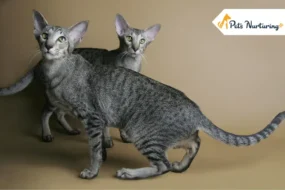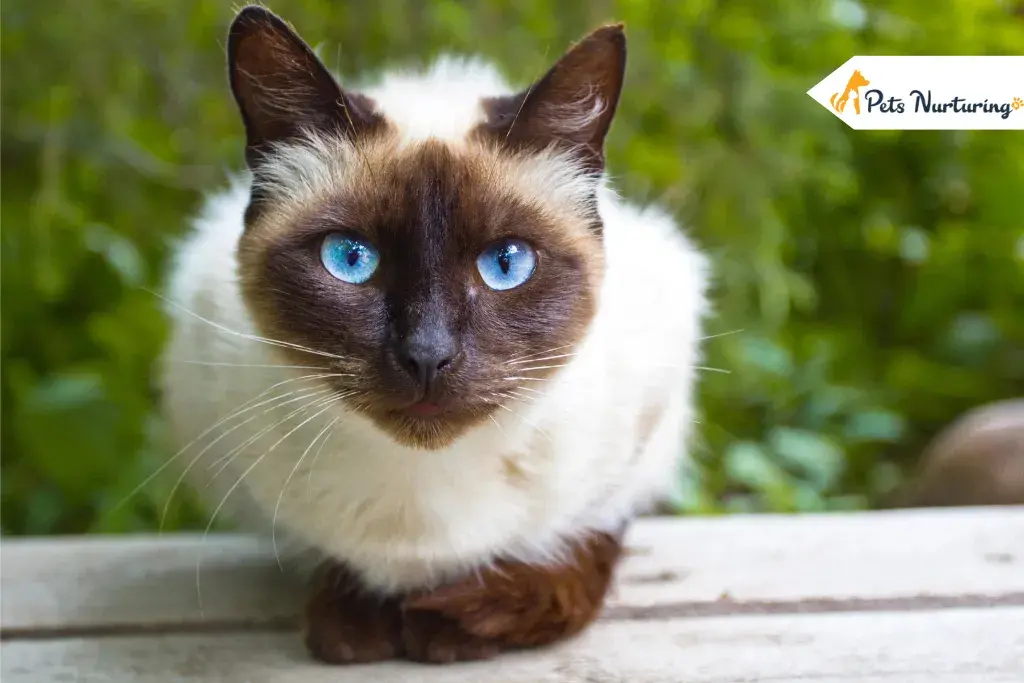
We can describe a Siamese cat in 3 words – Intelligent, Beautiful, and Affectionate. Now, we know that cats are really not as affectionate as dogs, but that’s completely untrue in the case of a Siamese. It is a dog-like cat that loves human attention.
This breed can easily win anyone over with its striking blue eyes and charming face. And that’s not all. They are extremely smart and well-behaved, making them ideal pets for cat lovers. But is a Siamese cat right for you? That’s what we are going to help you decide.
In this guide, we are going to discuss all the important information about the breed, from its origin and personality to how to care for them.
So, let’s begin!
Breed Overview
The Siamese is a medium-sized cat with a sleek appearance. One unique feature is its darker color patches on the face, ears, legs, tail, and feet. Moreover, they are hypoallergenic as well.
They are often called “meezers.” These cats are friendly and enjoy vocalizing with their owners. It is one of the earliest known types of Asian cat breeds.
The Siamese cat has been used to create several other breeds by mixing with different cats. There are two main types,
- The traditional (rounder head and slightly chubby body)
- The modern Siamese (slim with a wedge-shaped head)
Let’s learn a bit more about this amazing cat breed.
Siamese Cat Overview
Other Names: Thai cat and Meezer
Height: 8 to 12 inches
Weight: 6 to 14 pounds
Coat: Short
Coat Color: Seal, chocolate, lilac, blue and more
Temperament: Sociable, vocal, and affectionate
Eye Color: Blue
Life Span: 12 to 15 years
Hypoallergenic: Yes (Mostly)
Grooming Needs: Low to moderate
Origin: Thailand
History
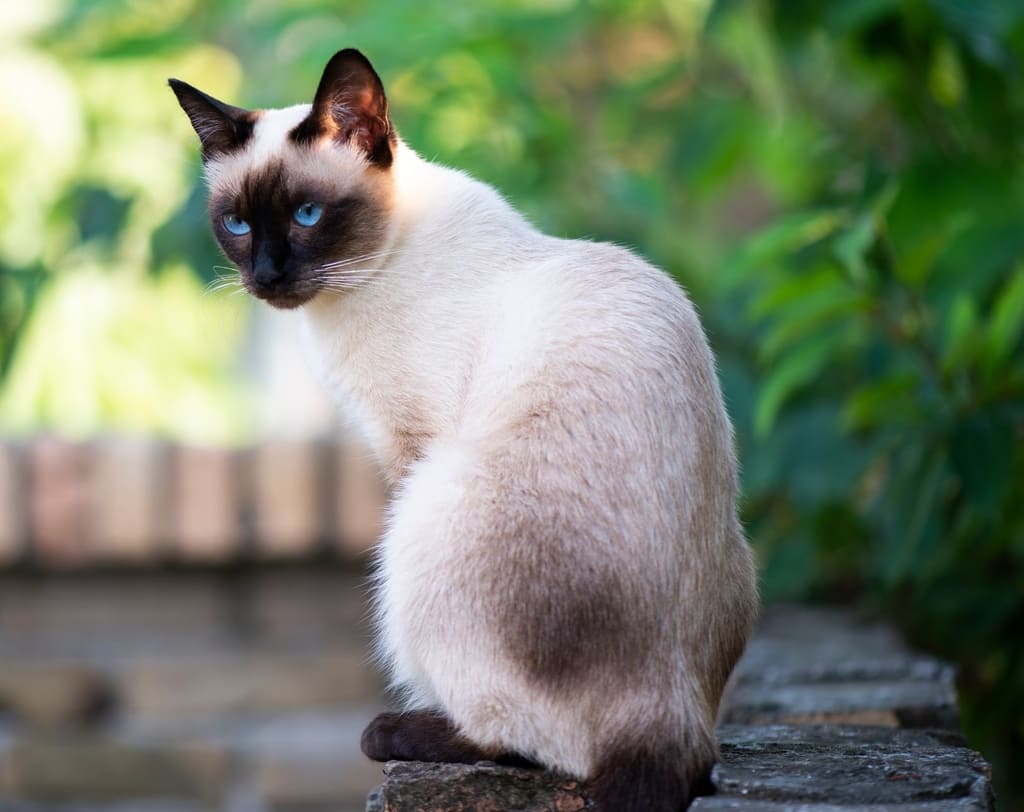
Origin in Thailand
Siamese cats originally came from Thailand, which was previously called Siam. This is where they got their name from. They have a rich history that traces back to ancient times in Thailand.
Descriptions and depictions of Siamese cats can be found in ancient manuscripts called the Tamra Maew (The Cat-Book Poems). It dates back to the Ayutthaya Kingdom (1351 to 1767 AD).
Legend has it that during the Burmese–Siamese war in 1767, the Burmese army looted the capital city of Ayutthaya. They took treasures and even rare Suphalak cats with them to Burma. This legend adds to the mystique surrounding Siamese cats in Thailand.
Entering America
The Siamese made its way to the West in the late 19th century. The first documented Siamese to reach the United States was a cat named “Siam.” It was sent to U.S. President Rutherford B. Hayes in 1878.
Entering the United Kingdom
In 1880, the king of Siam gifted two pairs of Thai cats to the English consul-general in Bangkok. They were brought to London, where they became very popular. In 1884, a breeding pair was brought to Britain. They attracted attention with their unique appearance and behavior. The first Siamese cat to win a champion title was Wankee in 1898.
Emergence of Modern Siamese Cat
Over time, breeders selectively bred Thai cats. This resulted in in a more slender and elongated body with a wedge-shaped head and large ears. This modern show-style Siamese became the standard in cat shows by the mid-20th century.
Some breeders were concerned about these extreme changes and potential health issues. In 1987, they formed the Traditional and Classic Cat International registry to preserve the old-style look of Siamese cats.
Two Types of Siamese Cat
Today, there are two main types of Thai cats – the modern show-style Siamese and the traditional Siamese. They are also known as the “Old-style Siamese” or “Classic Siamese.”
The terms “traditional” and “classic” can be confusing when talking about Thai cats. The founder of The Traditional Siamese Cat Association – Sheelagh Le Cocq, explains that the classic Siamese is a mix between the traditional and modern versions. This breeding stage happened between 1945 and 1970.
Growing Popularity
Thai cats have appeared in popular culture – like the Disney movie “Lady and the Tramp,” which featured Si and Am. Another famous Siamese cat starred in the television series “That Darn Cat!”
In recent years, there has been a growing interest in preserving the traditional Siamese. It leads to the recognition of the Thai breed by organizations like – The World Cat Federation (WCF) and The International Cat Association (TICA).
Appearance
The Thai cat is medium-sized and typically reaches its full size by the age of one. As we have discussed before, there are two main types of Siamese cats. Their appearance slightly differs from one another.
Modern Siamese Cat
Modern Thai cats have a slender build. They have a medium height proportionate to their body length. These cats typically have a taller and lighter build compared to the heavier traditional Siamese cats.
| Feature | Male | Female |
| Height | 10 to 12 inches | 8 to 10 inches |
| Weight | 8 to 10 pounds | 6 to 8 pounds |
Body
Modern Thai cats have an elongated and tubular body with well-defined muscles. Their physique is sleek and slender.
Head
The head of a Modern Siamese forms a perfect triangle from the tip of the nose to each tip of the ear. This gives them a distinctive look.
Nose
They have a straight nose, which contributes to the triangular shape of their head.
Eyes
They have almond-shaped and strikingly light blue eyes.
Ears
Their ears are large and set more towards the side of the head. They are a major feature of their triangular head shape.
Tail
Modern Thai cats have a slender tail that complements their sleek body. It is in proportion to the length of their body.
Distinct Color
The most characteristic feature of Modern Siamese cats is their pointed coloration. The ears, paws, face, and tail are darker than the rest of the body.
Traditional Siamese Cat
Similar to Modern Thai cats, Traditional Siamese cats also have a medium height relative to their body length. However, they are a bit heavier than modern Thai cats.
| Feature | Male | Female |
| Height | 10 to 12 inches | 8 to 10 inches |
| Weight | 10 to 14 pounds | 8 to 12 pounds |
Body
Traditional Thai cats have a moderate body length. They appear muscular and graceful. Their physique is not as elongated or tubular as the Modern Siamese.
Head
The head of a Traditional Siamese cat is rounded. It lacks the extreme triangular shape seen in the Modern Siamese breed.
Nose
They have a short nose with a gentle slope. This contributes to their softer facial features.
Eyes
Their eyes are the same – almond-shaped and light blue.
Ears
Their ears are medium-sized, with slightly rounded tips. They are more towards the top of the head.
Tail
Traditional Thai cats have a medium-length tail that tapers gradually.
Distinct Color
Like Modern Thai cats, Traditional Siamese cats also have pointed coloration, with darker faces, ears, paws, and tails.
Coat and Color
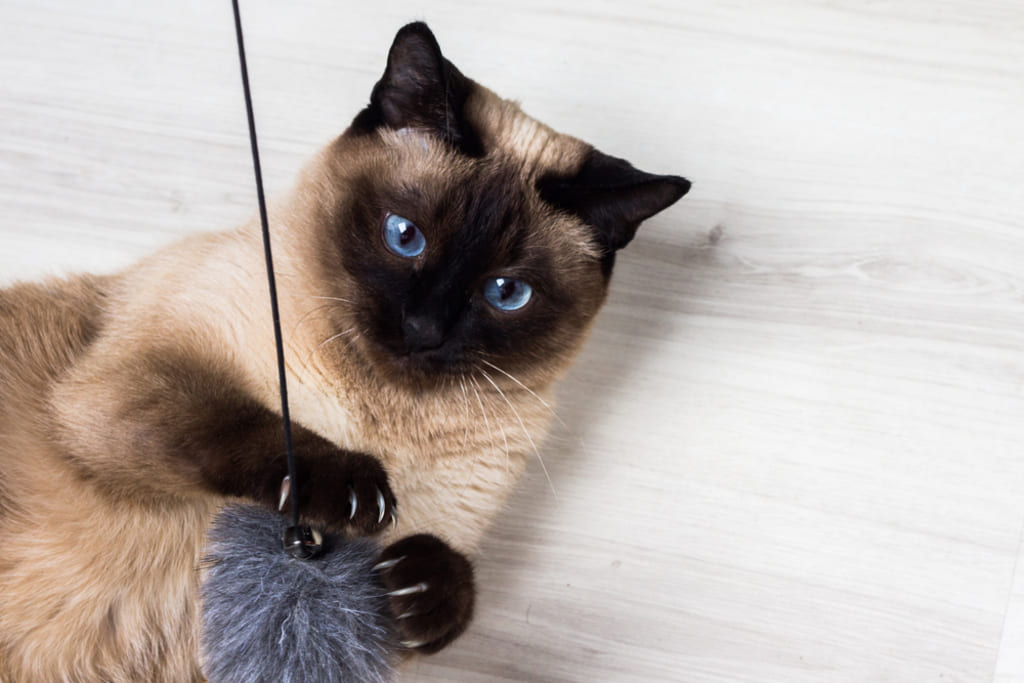
While you might know a Thai cat as cream-colored with dark points, they have actually different color combinations.
Siamese cats have a short, glossy coat that adheres closely to the body with no undercoat. This fur type improves their appearance.
They come in various point colors, including,
- Seal point (dark brown)
- Blue point (cool grey)
- Chocolate point (lighter brown)
- Lilac point (pale warm grey)
Siamese Cat Personality & Temperament
The Siamese cat temperament is friendly, and outgoing personality. This breed is incredibly intelligent and thrives on positive human interaction. They are loving and trusting towards their owners, but they can be sensitive to harsh words. So, it’s important to use positive reinforcement during training.
Many Thai cats are what we call “Velcro kitties,” meaning they stick close to their owners. They will follow you around the house, seeking pets and cuddles.
They love to cuddle and be held, although they also appreciate having some space to themselves. However, “doing your own thing” for a Siamese usually means staying nearby rather than being completely independent.
These cats can feel sad if left alone for too long. It’s best to have them in a home where someone is around most of the time or with other pets for company.
Siamese cats are often known for being talkative, with some meowing loudly to communicate with their owners. However, not every Siamese is chatty; some are more vocal than others.
They may form a particularly close bond with one person in the household. But they are generally affectionate towards everyone in the family as long as they receive lots of love and attention.
Despite their vocal nature, Thai cats have calm and friendly personalities. This makes them great companions for families with kids and other pets. Here are some Siamese personality traits:
- Thai cats are affectionate
- They are friendly towards both humans and other pets
- Siamese cats are kid-friendly and enjoy playful interactions
- They are playful
- Thai cats have high exercise needs
- They get along well with other animals in the household
- They exhibit low shedding and require minimal grooming
- Thai cats have high energy levels
- They are intelligent and quick learners
- Siamese cats are vocal
Health and Nutrition
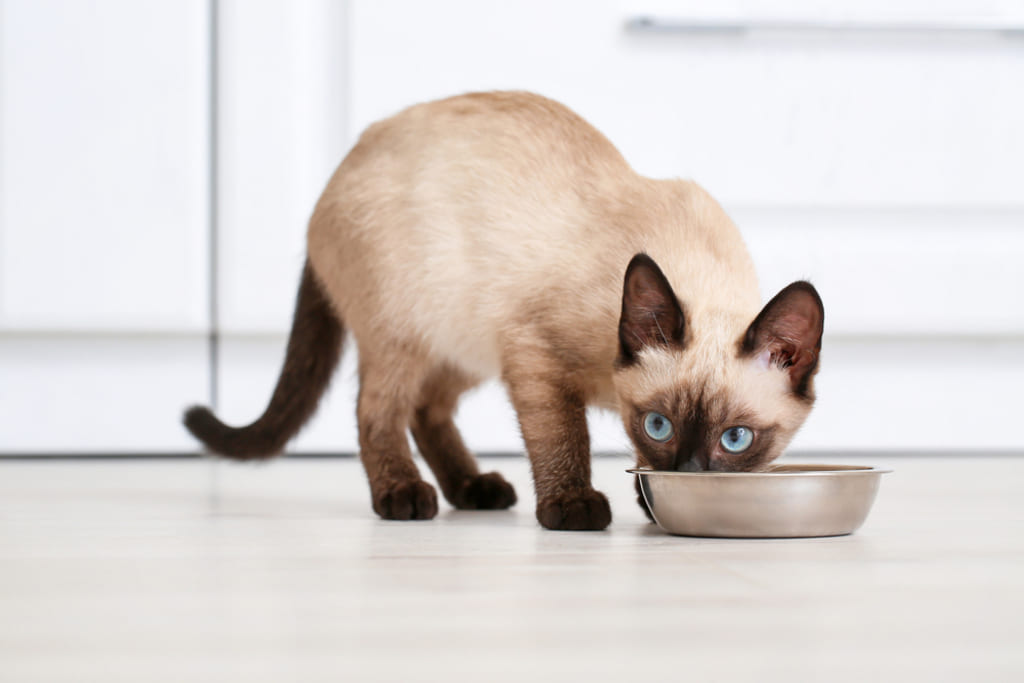
Choosing the Right Food
Provide your Thai cat with a high-quality commercial diet. It should be approved by the Association of American Feed Control Officials (AAFCO).
Dry cat food can help maintain your cat’s dental health, while wet food ensures they stay hydrated, especially if they don’t drink much water.
Your veterinarian can offer guidance on selecting the best diet for your cat’s specific needs.
Feeding Schedule
Thai cats naturally prefer small, frequent meals due to their hunting instincts. Consider offering two or more small meals throughout the day. Food puzzles and lick mats can help stimulate their minds during mealtime.
Portion Control
Some cats tend to overeat if food is always available. Consider offering two meals a day and removing any leftover food to prevent overeating and weight gain.
Monitor your Thai cat’s weight regularly and adjust their diet as needed. If your cat becomes overweight, your veterinarian may suggest a calorie-controlled diet.
They can recommend the appropriate portion size based on your cat’s activity level, age, and weight.
Nutritional Needs
As your cat ages, their nutritional needs may change. Consult your veterinarian to discuss any modifications needed to their diet.
Make sure your cat’s diet is complete and balanced, meeting AAFCO’s standards for essential nutrients. Additional supplements may be recommended by your veterinarian for specific health issues.
Common Health Problems
Thai cats typically live around 15 years. With proper care, some can reach their 20s. However, the breed is susceptible to certain health issues, like:
Asthma
Siamese cats can develop asthma. This causes symptoms like coughing and difficulty breathing. Environmental factors like dust and candles can worsen symptoms. Treatment may include special litter or medications to manage severe cases.
Pica
Thai cats may exhibit pica. It is a behavior where they eat non-food items like wool or strings. This can be dangerous and lead to poisoning or internal blockages. If your cat shows signs of pica, such as eating inappropriate objects or changes in appetite, consult your veterinarian immediately.
Hereditary Retinal Degeneration
While more common in other breeds, Thai cats may experience genetic retinal degeneration, leading to vision loss. Symptoms usually start around 1 to 2 years old. It can progress from night blindness to total blindness. Genetic testing of parents is advised.
Amyloidosis
Siamese cats may be prone to amyloidosis. It is a condition where abnormal protein deposition affects various organs. This leads to issues like liver or kidney disease. Genetic testing of parents is recommended by responsible breeders to reduce the risk.
Dental Disease
Thai cats can develop dental issues. Regular teeth brushing with cat-safe toothpaste and veterinary checkups are crucial for preventing dental disease. Professional dental cleanings may be needed under anesthesia when necessary.
Hypertrophic Cardiomyopathy
A congenital heart defect is seen in Siamese cats, which can result in heart failure.
Make sure your Thai cat receives routine vaccinations, and regular checkups to maintain their health.
Behavior and Training
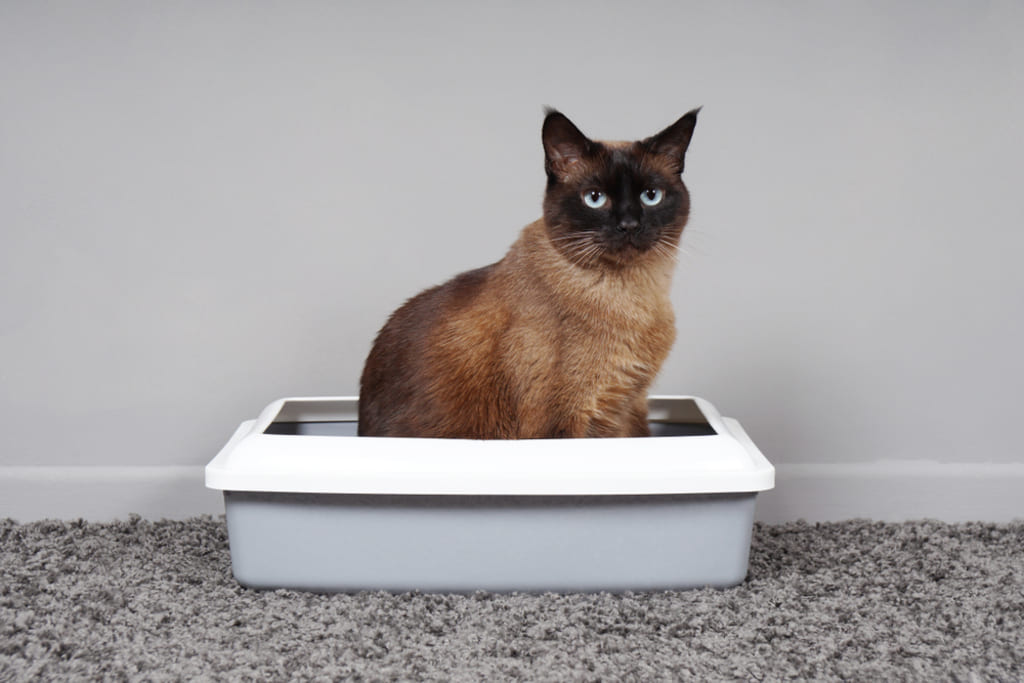
Thai cats are often described as lively and vocal, though individual personalities can vary. They can be affectionate companions, suitable for households with children and other pets. Introductions to new animals and people should be gradual and supervised.
Early socialization is important for Siamese cats. They thrive on affection and attention. These cats may form strong bonds with their owners and may seek attention from visitors. When feeling neglected or wanting interaction, Thai cats may vocalize loudly with meows or trills.
Thai cats respond well to positive reinforcement training due to their gentle nature. They are intelligent and enjoy engaging in activities with their owners. This makes them great candidates for tricks, leash training, and other interactive exercises.
Exercise Needs
Siamese cats enjoy climbing and benefit from having a cat tree or similar structure for this purpose. They also appreciate puzzle toys and teaser toys to keep them entertained. It’s important to provide these outlets to prevent boredom and potential mischief, such as climbing curtains.
Thai cats are intelligent, active, and curious, making them receptive to training. Clicker training is an effective method for teaching them various tricks, including fetching toys.
Here are some fun activities for Thai cats:
- Walks on a leash and harness
- Interactive feeding puzzles and snuffle mats
- Clicker training sessions
- Watching birds from a safe spot indoors
- Playing with interactive toys
- Enjoying cuddles and gentle petting
- Being in the company of people
Grooming Needs
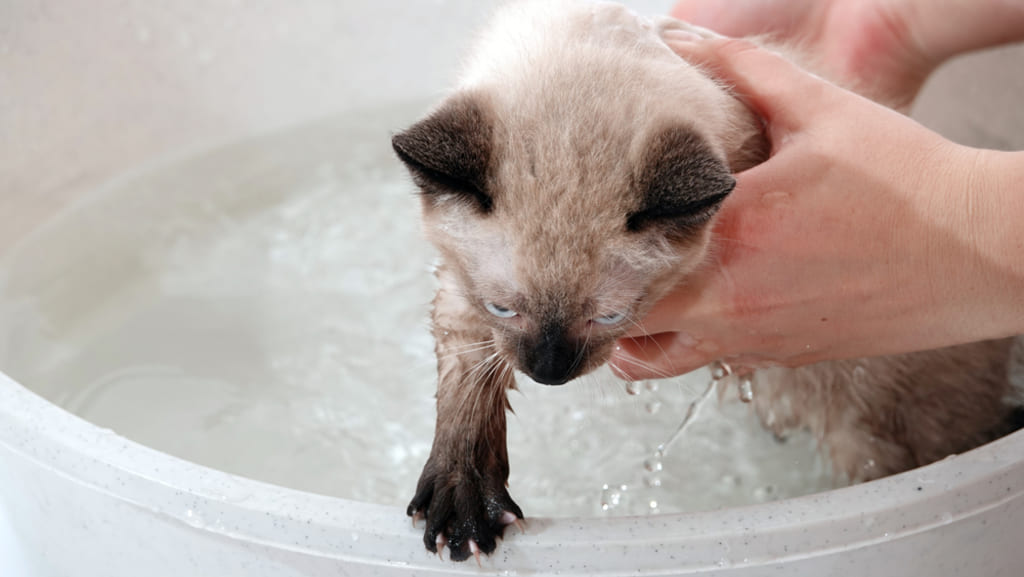
Siamese cats don’t need much grooming because of their short coat. However, you must still follow these grooming care tips:
Skin Care
Thai cats don’t need special baths or skin care. If you see your cat scratching a lot or showing signs of skin irritation, it’s best to schedule a vet checkup.
Coat Care
Siamese don’t shed much, but it’s wise to brush them weekly to remove loose hair and avoid hairballs. Long haired Thai cats need more grooming.
Eye Care
Siamese cats generally don’t need extra attention for their eyes. But if you notice signs of vision problems, it’s important to consult your vet.
Ear Care
Thai cats typically don’t need specific ear care. But if you notice any unusual ear discharge, it’s essential to book a checkup with your veterinarian promptly.
Nail Trim
Make sure to trim your indoor cat’s claws every 10 to 14 days. Offering a scratching post can protect your furniture and wood surfaces.
Dental Care
Don’t forget about dental care. Introducing regular tooth brushing to your cat from a young age will make it easier and keep their teeth in good shape.
Are Siamese Cats Hypoallergenic?
Thai cats are known for producing less of the Fel d 1 protein that often triggers allergies in people. This is why they are sometimes considered hypoallergenic cats.
While there isn’t a cat that is completely hypoallergenic, those with allergies might find relief with cats that shed less often. Since Thai cats have short fur that doesn’t shed heavily, they could be a good option for allergy sufferers.
However, it’s essential to consult with your doctor about the best plan for managing cat allergies before bringing any cat into your home.
Price
The cost of Siamese cats for sale varies depending on factors like the location, breeder, and the kitten’s quality. Generally, prices range from $200 to over $1,000. However, some exceptionally high-quality Siamese kittens for sale are available for as high as $2,800.
It’s important to note that the breeder’s reputation also plays a significant role in pricing. Opting for a pedigreed cat from a reputable breeder recognized by organizations like TICA and the Cat Fanciers Association may warrant the higher Siamese cat for sale.
Siamese Cats for Adoption
Siamese cats for adoption can range from approximately $250 from a shelter.
Shelter adoptions typically fall on the lower end of the price spectrum. You might find a purebred Thai cat from a local breeder. Alternatively, you can explore Siamese kittens for adoption options through rescue organizations like,
- Siamese Rescue
- Adopt a Pet
- Petfinder
Siamese Cat Lifespan
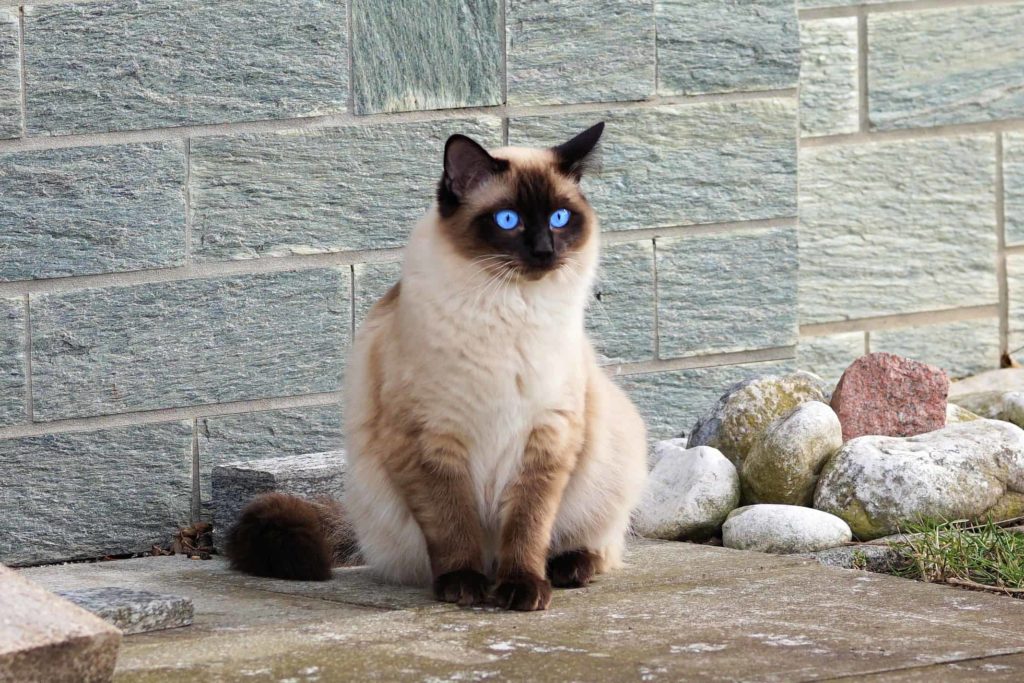
Thai cats typically live around 15 years, surpassing the lifespans of many other breeds. However, Siamese cat lifespan can vary based on gender.
Female Thai cats generally live between 12 to 20 years, while males typically live 15 to 20 years. A Siamese named Scooter holds the record as the world’s oldest Siamese male cat. He lived up to the age of 30.
He was previously recognized in the Guinness Book of World Records as the oldest living cat. Many of these cats live well into their twenties, with some reaching over 20 years old.
FAQs
You can search on Google to get information about local breeders offering Siamese kittens for sale.
You can find Siamese kittens for adoption at online websites like Adopt-a-Pet or with local rescue organizations.
Siamese personality traits include – friendly, affectionate, and social, making them great companions.
Yes, long haired Siamese cats, also known as Balinese cats, are relatively rare compared to their short-haired counterparts.
Conclusion
This is all you need to know about the Siamese cat breed. They are friendly, affectionate, and love to be around humans. They have dog-like behavior and will follow you around the house. The best thing is that they will even cuddle with you.
They thrive on social interaction and readily engage with both people and other animals, making them an excellent fit for lively homes. Known for their chattiness, Thai cats are quite vocal.
However, remember that they don’t like being left alone for long periods of time. So, make sure someone is always around them and also offer them proper mental and physical stimulation.
Discover more:









